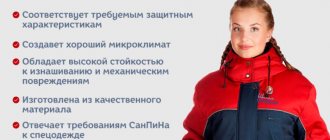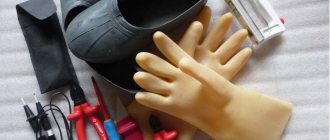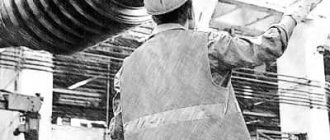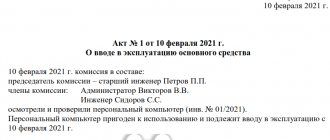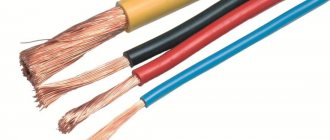How to determine the wear and tear of personal protective equipment
| How to determine the wear and tear of personal protective equipment September 18, 2014 What are the terms for using PPE and who set them? When providing employees with personal protective equipment, the employer must remember that any PPE becomes unusable over time. This depends both on the materials from which they are made and on the conditions of their use. Therefore, each type of protective equipment has its own terms of use. In accordance with the law, PPE can be issued to:
The standards for issuing PPE, which are given in the relevant regulations, have symbols. If, for example, 6 pairs, 1 set, or just a number is written in the column “issue standards for the year,” this means that during the year the employee must be issued the specified amount of PPE of this type. If the entry “until wear” is written, this means that PPE is not issued for a year, but until it becomes unusable as a result of the loss of its protective properties over time or intensive use. Such PPE typically lasts much more than one year. If the column contains the inscription “by belts,” the period of use is determined in accordance with paragraph 8 of the note to Appendix No. 5 of Order No. 357n of the Ministry of Health and Social Development of Russia dated June 22, 2009. Duty PPE is issued only for the duration of the work for which it is intended. For example, a raincoat used only for protection from rain when a guard (watchman) walks around the territory. Its service life is also “till wear”. The “wear-out” period is also established for PPE not specified in the standard issuance standards, but prescribed based on the results of a special assessment of working conditions. This applies to the following clothing and equipment:
How to determine whether PPE is worn out This issue can be most easily resolved in relation to personal protective equipment issued for a certain period. If an employee is entitled to 6 pairs of gloves per year, the employer should try to provide the required number. Even if the employee turned out to be diligent, and the previously issued PPE is still in good condition, he still needs to be given the required amount of personal protective equipment against signature and make a note about this on his personal card. However, the employer has the right to use PPE for its intended purpose even if it has expired, but is suitable for further use. The percentage of wear, as well as the possibility of further operation, can be determined either by the employee responsible for this or by the labor protection commission. After examining the PPE, an authorized employee or commission draws up a report indicating the percentage of its wear and the possibility of further use. In this case, organoleptic control methods (visual inspection, palpation) can be used. It is advisable to compare the PPE being tested with the standard. As a last resort, new PPE that has not yet been used should be used. The suitability of PPE is determined using the manufacturer's instructions. The employer’s task will be greatly facilitated by purchasing certified personal protective equipment, since the manufacturer in this case voluntarily complies with the requirements of GOST R EN 365-2010, introduced on January 1, 2012. It specifies in detail what information about personal protective equipment should be reflected in the instructions for their periodic inspection and technical operation. For PPE with a “wear-out” period, the employer needs to establish the frequency of checks for suitability for use. For example, it may be one calendar year. To record inspections of such PPE, a journal is drawn up in which records of suitability are made, indicating the date of the next inspection. Is it possible to extend the period of use of PPE? This question is answered by paragraph 22 of the Intersectoral Rules. The Occupational Safety and Health Commission or an authorized employee inspects the PPE handed in by the employee after the end of the period of use of the PPE. Having established that the personal protective equipment can still be used, it is again issued to the employee. In this case, it is necessary to draw up an act and also issue an order indicating that the PPE is suitable for further use. Despite the fact that the obligation to report the failure of personal protective equipment rests with the employee, the employer in this case needs to exercise caution and also monitor the condition of the protective equipment. Especially if this concerns personal protective equipment such as safety belts, dielectric mats and gloves, etc., since they have the function of protecting against the most severe injuries. For PPE issued “before wear-out”, it is not logical to extend the period of use. However, in practice, accountants still require that a specific operating date be set for them. They need it to make it more convenient to calculate depreciation and make other calculations. You can determine the period from the catalogs of the clothing manufacturer or in the passport of the PPE itself. They indicate the shelf life of the product. In relation to PPE used for protection against electrical hazards, you should use the Instructions for the use and testing of protective equipment in electrical installations. For some PPE, which must be issued “before wear out,” the regulations set a deadline for use. For example, for safety glasses it cannot be more than one year. Answers to your questions What to do if PPE becomes unusable ahead of schedule? If the issued PPE has become unusable ahead of schedule, you need to take a written explanation from the employee about the circumstances of the damage. Then draw up inspection reports and write-off of PPE, and then issue new ones to the employee. What special clothing is required for a gas boiler operator? Obviously, the question in question is about the order of the Ministry of Health and Social Development of Russia dated September 1, 2010 No. 777n, which approved standard standards for issuing PPE for employees working in special temperature conditions or associated with pollution. Clause 68 of Section VIII of Appendix 1 to this document lists the PPE that is required for the boiler room operator. The standard standards do not specify whether the operator works in a gas or other boiler house. Therefore, these standards can be legally used to issue PPE to the operator of a gas boiler house. Should PPE be issued to a part-time worker? Part-time workers must be provided with personal protective equipment on the same basis as employees who perform their duties at their main place of work. The most necessary regulations |
| Document | Will help you |
| Part two art. 212 Labor Code of the Russian Federation | Make sure that the employer is obliged to provide workers with personal protective equipment |
| Order of the Ministry of Energy of Russia dated June 30, 2003 No. 261 | Clarify how the suitability of PPE used for protection against electricity is checked |
| Clauses 5 and 6 of Appendix No. 5 of the order of the Ministry of Health and Social Development of Russia dated June 22, 2009 No. 357n. | Find out what service life is established for clothing issued by belts and for the period “until worn out” |
| Order of the Ministry of Health and Social Development of Russia dated June 1, 2009 No. 290n | Find out who can extend the period of use of PPE |
Features of writing off special clothing
The procedure for writing off special protective clothing in accounting depends on which fund it is assigned to. Typically, workwear in an organization is included in production inventories. The criterion for accounting for workwear in an organization is fixed in the accounting policy.
Workwear is written off in two ways:
- At the end of the period of use (if used for more than 1 year);
- Upon commissioning (if used for less than 1 year).
When the cost of workwear is up to 40,000 rubles, it is classified as inventory and written off in equal parts throughout its entire service life.
Separately, it should be noted that many enterprises provide clothing that is not intended to protect against harmful production factors and only indicates that the employee belongs to this organization. Such clothing cannot be classified as special clothing and the accounting for such clothing is completely different.
How to determine the suitability of PPE and extend the wear period
| Name | How to determine the suitability of PPE and extend the wear period |
| Type | Documentation |
| How to determine the suitability of PPE and extend the wear period Question Protective equipment tends to run out, wear out or break. And it happens that they live long and are suitable for use even after the end of their wear period. Who and how determines the degree of wear and tear of PPE in order to reissue it? Who sets the new wearing dates? The employer, by law, provides employees with free protective equipment and protective clothing. He is also obliged to monitor the serviceability of the issued PPE. If clothing, footwear or other PPE fails, it must be repaired or replaced. Otherwise, the defect will interfere with operation and may cause an accident. Due to his busy schedule, the head of the organization cannot personally control the serviceability of PPE. This is done by the labor protection commission (clause 22 of the Intersectoral Rules for Providing PPE for Workers, approved. |
We renew and/or write off Workwear! Instructions for Use!
by order of the Ministry of Health and Social Development of Russia dated June 1, 2009 No. 290n; hereinafter referred to as Intersectoral Rules). Members of this commission can assign new wearing periods for suitable PPE
.
The maximum service life of protective equipment is determined by GOSTs and Standard Industry Standards for the free issuance of PPE (approved by Order of the Ministry of Health and Social Development of Russia dated December 14, 2010 No. 1104n). The recommended shelf life of the product can be found in the passport of the PPE itself or in the manufacturer’s catalog.
For example, the wearing period of a suit for protection against general industrial pollution and mechanical impacts is limited by standards to nine months. As soon as this period expires, the employee hands over the workwear to the employer. The commission evaluates the wear rate of the suit and its suitability for further use. Based on the results of the assessment, the commission decides whether a new wear period can be set for the suit. How is wear percentage and suitability determined?
Protective equipment is inspected and felt, compared with the same PPE, only new.
This makes it possible to detect damage, faulty mechanisms, and functional unsuitability. Based on the data received, the commission draws up an inspection report. In the act, a separate column indicates the percentage of wear. This value is established as an estimate. There is no formula that can be used to calculate the exact percentage of wear. The commission enters information about the extension of the service life into the personal card for recording the issuance of personal protective equipment.
NOTE
In small organizations there is no need to create a PPE committee. Its functions can be performed by one responsible employee on behalf of the employer. How to make PPE usable again
If the detected deficiencies can be eliminated, the employer does this at his own expense. PPE can be reused after cleaning, washing, disinfection, degassing, decontamination, dust removal, neutralization, and repair.
Defective and contaminated PPE should not be used. Workers must inform the employer if something goes wrong (clause 28 of the Inter-Industry Rules). What to do with PPE “before it wears out”
If PPE has a wear-out date, it still needs to be checked periodically. How often to do this is decided by the commission. To record checks of such PPE, the commission draws up a log. During periodic inspections, the commission records the suitability of the PPE and indicates the date of the next inspection.
The regulations set a deadline for use of such PPE. For example, for a safety helmet for a forklift driver, it cannot be more than three years old (Model standards, approved by order of the Ministry of Health and Social Development of Russia dated June 22, 2009 No. 357n).
An example of filling out a personal protective equipment inspection report
Accounting entries generated when writing off workwear
According to the chart of accounts approved by order of the Ministry of Finance of the Russian Federation dated October 31, 2000 No. 94n, movements in workwear are recorded on account 10, subaccounts “Workwear in warehouse” and “Workwear in use.”
For controlled accounting of used workwear, written off on a one-time basis during commissioning, you can enter an off-balance sheet account “Workwear in operation” (clause 8 of FSBU 5/2019).
Example (continued)
Design Repair LLC reflected the entries for write-off of workwear:
| Period | Actions | Dt | CT | Sum |
| May | Workwear has been received into the warehouse | 10 “Workwear in the warehouse” | 60 | RUB 5,420 = 1,290 × 2 + 320 × 1 + 130 × 12 + 960 × 1 |
| The special clothing was put into operation | 10 “Workwear in use” | 10 “Workwear in the warehouse” | 4,130 rub. =1,290 × 1 + 320 × 1 + 130 × 12 + 960 × 1 | |
| June | The wear and tear of workwear for the month is reflected | 20 | 10 “Workwear in use” | 214 rub. = 1290/12 + 320/12 + 960/12 |
| The cost of gloves has been written off | 20 | 10 “Workwear in use” | RUB 1,560 = 130 × 12 | |
| The cost of gloves is reflected on the balance sheet | 012 “Workwear in use” | — | RUB 1,560 | |
| September | The residual value of the suit has been written off | 94 | 10 “Workwear in use” | 860 rub. |
| 91 | 94 | 860 rub. | ||
| October | The residual value of the headdress has been written off | 94 | 10 “Workwear in use” | 187 rub. |
| 73 | 94 | 187 rub. | ||
| November | The cost of gloves has been written off from the balance sheet | — | 012 “Workwear in use” | RUB 1,560 |
| December | The residual value of the sold suit has been written off | 91 | 10 “Workwear in use” | RUB 967.50 |


